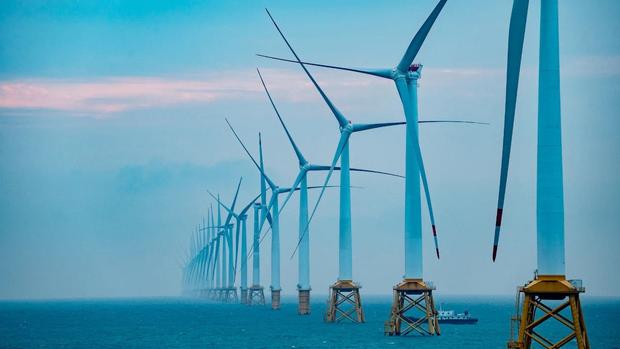 This undated file photo shows the Yangjiang Nanpeng Island offshore wind farm. (PHOTO / CHINA GENERAL NUCLEAR POWER CORP)
This undated file photo shows the Yangjiang Nanpeng Island offshore wind farm. (PHOTO / CHINA GENERAL NUCLEAR POWER CORP)
China led the world in new offshore wind installations for the third year in a row despite the global COVID-19 pandemic, according to new data released by the Global Wind Energy Council.
In its latest market intelligence report, the GWEC said the global offshore wind industry had its second-best year ever in 2020, with over 6 gigawatts of new capacity installed.
The growth was driven by a record year in China as the nation added 3 GW and topped the world in new annual offshore wind capacity for the third year running, said the report which was released on Feb 25
The growth was driven by a record year in China as the nation added 3 GW and topped the world in new annual offshore wind capacity for the third year running, said the report which was released on Feb 25.
The figures mean that China accounted for half of the new offshore wind capacity installed globally last year.
This comes as the country is doubling down on a goal to boost the installed capacity of wind and solar power to more than 1,200 GW by 2030 and boost the share of non-fossil fuels in primary energy consumption to around 25 percent.
READ MORE: S. Korea unveils US$43b plan for world's largest wind farm
According to GWEC data, steady growth in Europe accounted for most of the remaining new capacity last year, led by the Netherlands which had nearly 1.5 GW of new offshore wind installations in 2020, making it the second-largest market for new capacity in 2020 after China.
Overall, global offshore wind capacity now exceeds 35 GW — a 106 percent increase over the past five years, the GWEC says.
It said China has now surpassed Germany in terms of cumulative installations, becoming the second-largest offshore wind generator globally with the UK remaining in the top spot.
Feng Zhao, head of market intelligence and strategy at GWEC said: “The continued growth of the offshore wind industry globally throughout the pandemic is a testament to the resilience of this booming industry.
“Although China was hit first by the COVID-19 crisis, the impacts on the offshore wind sector were minimal, resuming ‘busines-as-usual’ as early as March 2020.”
China’s current feed-in-tariff for offshore wind power, which incorporates a subsidy, is set to expire by the end of 2021
ALSO READ: Offshore wind power efforts gain ground
China’s record-breaking growth is expected to continue in 2021, driven by an offshore wind installation rush to meet China’s feed-in-tariff deadline by the end of this year, the analyst said.
China’s current feed-in-tariff for offshore wind power, which incorporates a subsidy, is set to expire by the end of 2021.
While Europe remains the largest offshore wind market globally, Asia Pacific will play an increasingly important role driving industry growth as major economies such as Japan and South Korea have recently established ambitious offshore wind targets, Zhao said in a statement.
“The US will also become an increasingly important market for offshore wind, as the new administration has made it clear they are working to accelerate growth of this crucial industry,” he added.
From almost no offshore wind farms in 2015, Asia’s operational capacity has grown to more than 6 GW today, according to Rystad Energy, an independent global energy consultancy.
In a report issued in December, Rystad said the growth in Asia had been largely fuelled by China with Asia’s installed base expected to rise sixfold by 2025, when it will reach 52 GW putting it on par with Europe, the global offshore wind leader.
Rystad said China has contributed more than 94 percent of Asia’s current operational offshore wind capacity.
“The country now accounts for 5.9 GW of the continent’s 6.3 GW of offshore wind capacity, having already surpassed its target of 5 GW by 2020,” Rystad said.
China is forecast to see high activity levels continue between 2021 and 2024, before slowing down in 2025, according to the consultancy firm.
Rystad expects the global installed offshore wind capacity to increase by 11.8 GW in 2021 with China continuing to lead the new capacity additions, contributing 63 percent of the expected growth.
With China planning to phase out feed-in-tariffs by the end of this year, many developers are rushing to complete projects, Rystad said.
“China had a construction backlog of more than 10 GW going into 2020 and Chinese developers are racing to reach maximum commissioning by the end of the year to claim full feed-in-tariffs.
“This means 2021 is going to see major capacity additions, particularly since some projects initially scheduled for commissioning in 2020 ended up slipping into 2021,” said Alexander Fiotre, Rystad Energy’s project manager for Offshore Wind.
Robert Liew, principal analyst at energy and resources consultancy Wood Mackenzie, said floating offshore wind platforms “could be the net frontier in wind power development” in Asia going forward.
He said a significant market for floating offshore technology is now starting to emerge in Asia.
“At the moment, a number of demonstration projects are being planned, although the scale of deployment is still limited compared to conventional fixed bottom technology,” Liew said.
“Maintaining power supply will be a key challenge for Asia as legacy thermal plants reach the end of their project life and the opportunity for new-build coal and nuclear are severely limited.”
Liew said two north Asian markets — South Korea and Japan — face projected thermal and nuclear capacity retirements totalling 89 GW over the next 10 years.
“Governments in Southeast Asia are increasingly looking to renewables to fill the supply gap but due to land constraints, scalable options are limited.
“Floating offshore wind is starting to gain more attention, but the high cost remains a major barrier to the widespread adoption of this technology.”


